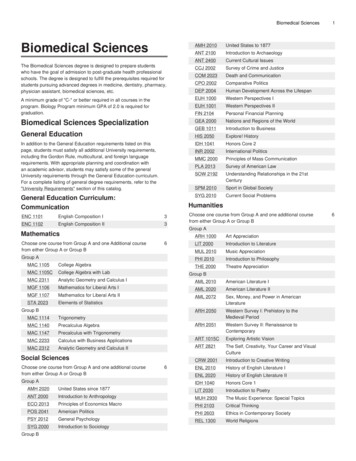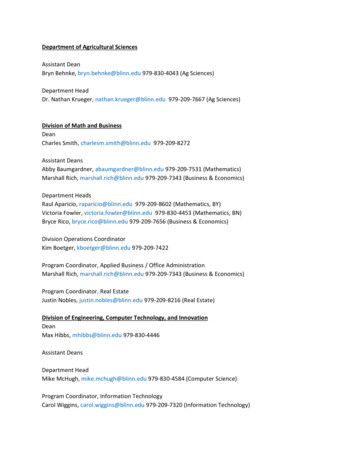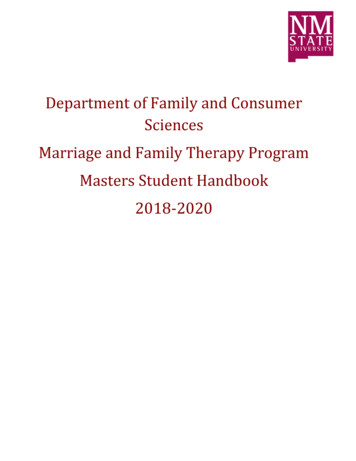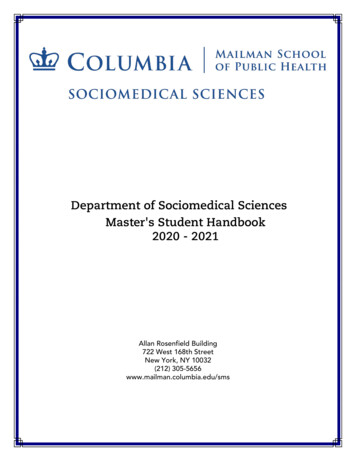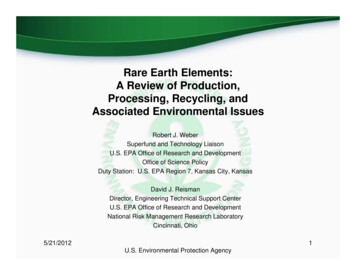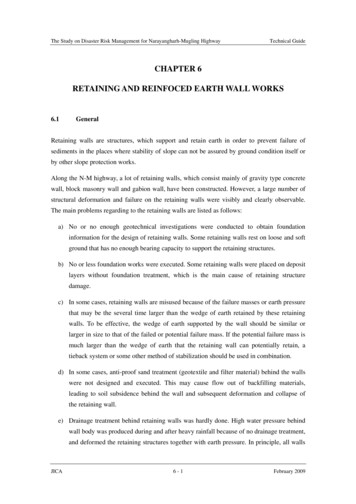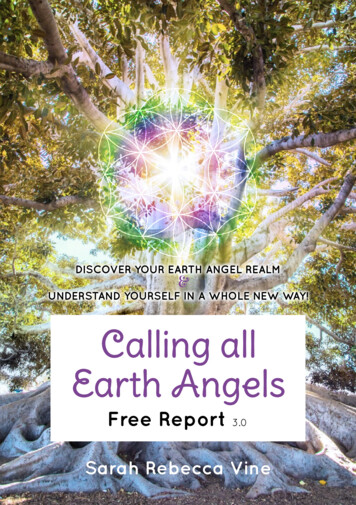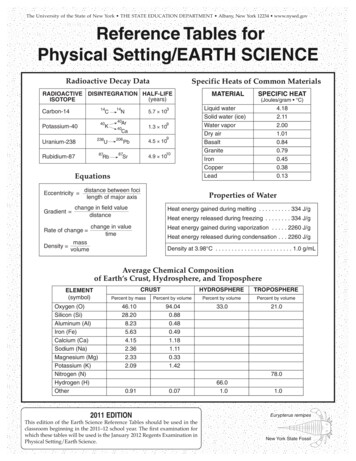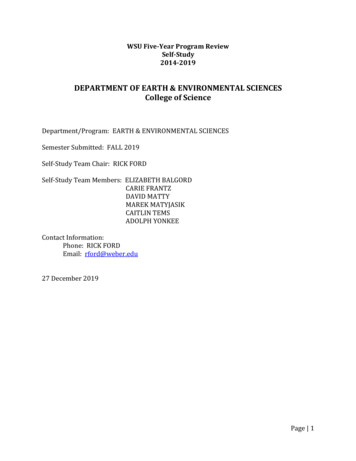
Transcription
WSU Five-Year Program ReviewSelf-Study2014-2019DEPARTMENT OF EARTH & ENVIRONMENTAL SCIENCESCollege of ScienceDepartment/Program: EARTH & ENVIRONMENTAL SCIENCESSemester Submitted: FALL 2019Self-Study Team Chair: RICK FORDSelf-Study Team Members: ELIZABETH BALGORDCARIE FRANTZDAVID MATTYMAREK MATYJASIKCAITLIN TEMSADOLPH YONKEEContact Information:Phone: RICK FORDEmail: rford@weber.edu27 December 2019Page 1
1. CONTEXT AND STRATEGIC PLANNING1.1 Background:For more than five decades, Weber State University has successfully pursued a dualmission by offering a wide range of baccalaureate and graduate programs while meetingregional community-college needs. Our vision is for Weber State University to be thenational model for a dual-mission university that integrates learning, scholarship andcommunity (WSU, ion and values.htmlThe Department of Earth and Environmental Sciences is one of seven departments withinthe College of Science (CoS) at Weber State University. It provides undergraduateeducation in geology, hydrology, environmental science, and geospatial technologies(remote sensing and geographic information science) for students wishing to complete thefollowing degrees: Bachelor of Science in geology; Bachelor of Arts in geology; Bachelor ofScience in applied environmental geoscience; and Bachelor of Science in Earth scienceteaching. The department supports other degree programs on campus by providing minorprograms of study in geology, Earth science teaching, and geospatial studies, as well asgeoscience emphasis areas for students pursuing a Bachelor of Integrated Studies (BIS). Aninstitutional certificate of proficiency in geospatial analysis is also offered. The departmentalso provides service courses for other majors and minors, including the Bachelor ofScience in botany (Botany Department, College of Science), Bachelor of Science in zoology(Zoology Department, College of Science), Bachelor of Science in geography (GeographyDepartment, College of Social and Behavioral Sciences), Environmental Studies Minor(interdisciplinary), and the Urban and Regional Planning Emphasis (College of Social andBehavioral Sciences). EES also offers an introductory Earth science course (GEO 1350 PS)designed for Elementary Education majors (College of Education). Lastly, the Departmentof Earth and Environmental Sciences supports the broader mission of the University byproviding physical-science (PS) general-education courses for all students and by engagingthe local community through Earth science-related-outreach activities and responses topublic inquiries. Appendix G provides a brief history of the Department.Unique features of the department’s programs include the integration of a traditionalgeoscience curriculum with course work in the growing field of geospatial technologies atthe undergraduate level, an emphasis on field-based learning, robust support forundergraduate research, well equipped analytical labs, and a cost-effective summer fieldcamp for geology majors. We are particularly proud of our accomplishments in the area ofundergraduate research. In the past five years, approximately 120 students (students werecounted more than once if they participated in multiple UR projects) associated with theDepartment of Earth and Environmental Sciences (majors, minors, and microbiologystudents working with Carie Frantz) participated in 14 faculty-guided undergraduateresearch projects, resulting in approximately 40 presentations at national or regionalscientific conferences and/or the annual WSU UR Symposium (see Section 6.7.3 andAppendix H). Faculty members also encourage and support geoscience-relatedPage 2
extracurricular activities and the department is the home to an active Geology Club andSigma Gamma Epsilon chapter (national honor society for Earth science students).Student retention and timely graduation are a focus of the faculty and staff. Based on dataprovided to the department by the Office of Institutional Effectiveness, we had a total of 79graduates (bachelor’s degrees and certificates) over the last 5 years, averaging 15.8/year(Appendix A). Total student credit hours (SCHs) ranged between 5,729 (2014-15) and6390 (2018-19) over the same period (Appendix A). The variation in SCHs roughlycorrelates with overall university enrollment trends. In Fall 2019, the distribution ofmajors (including double/dual majors) in our various degree and certificate programs was:Geology (BS/BA):63Applied Environmental Geoscience (BS): 31Earth Science Teaching (BS):3Geospatial Analysis (Certificate):12TOTAL109Lastly, the Department of Earth and Environmental Sciences has benefited greatly from achange in our academic home and facilities since the time of our last program review(2012-2013). The Department, along with the rest of the College of Science, is now housedin the attractive and inviting Tracy Hall Science Center, which opened in August 2016.Several EES faculty members were significantly involved in the planning and programmingfor this LEED Gold-certified building, as well as leading the ongoing effort to fully equip theCollege’s various teaching and research laboratories.1.2 Strategic Planning:Recently, the College of Science has been engaged in strategic planning and has identifiedfour strategic initiatives, on which each of its departments/programs will collaborate toachieve: (1) Develop a new interdisciplinary Environmental Science BS; (2) Revitalize ourvarious secondary science and mathematics teaching programs; (3) Focus on workforcereadiness across all degrees and programs; and (4) Promote teaching excellence and thewidespread adoption of high-impact educational experiences (HIEE) and active-learningpedagogies. The Department of Earth and Environmental Sciences (EES) has identifieddepartment-level strategic initiatives (section 1.3) that we think will advance our programsand substantially contribute to our college-level goals.The EES faculty and staff are very much focused on the future of our department and haveexpended considerable thought and effort over the past two years to analyze and revise ourcurricula (see section 3.3 and Appendix J), in conjunction with major national efforts (NSFsponsored summits on The Future of Undergraduate Geoscience Education), to betterprepare students for the challenges of the 21st century. Our major short-term goals for the2018-2019 academic year were to finalize our curricula revisions and to rebrand theDepartment of Geosciences as the Department of Earth and Environmental Sciences. Thesegoals were successfully accomplished. In addition, in Fall 2018, the Provosts Officeprovided funding for 1.5 new faculty positions in the CoS in support of the College’sEnvironmental Science initiative and the joint EES-Geography Geospatial EducationPage 3
program. EES faculty chaired successful searches for these two positions, as well as asearch for a new EES Lab Manager, also supported by new funding from the ProvostsOffice. The environmental science search focused on bringing applied climate scienceexpertise to the College and the departmental home of the successful candidate was leftopen. Dr. Caitlin Tems (PhD University of Southern California) accepted the Dean’s offerand it was decided that EES will be her departmental home. Dr. Ryan Frazier (PhDUniversity of British Columbia) was selected for the geospatial science position and he hasa joint appointment across two colleges (EES/CoS and Geography/S&BS), a bold andexciting cross-college collaboration. Lastly, Sara Summers (WSU class of 2010, MSUniversity of Notre Dame) joined the EES team as Lab Manager in January 2019.Going forward, we are excited to leverage these recent accomplishments and newfaculty/staff positions to achieve our strategic goals, outlined below. We also recognize thegreat investment that has been made in our department, and we will strive to ensure thisinvestment pays significant dividends in terms of student success and meeting strategicgoals.1.3 Strategic Goals:The long-term employment outlook for geoscience graduates is very good, especially ifgraduates are willing to relocate to other states. The Bureau of Labor Statistics predictsthat the demand for geoscientists, hydrologists, and environmental scientists will grow 68% (2018-2028), faster than the average rate of job growth. In addition, the AmericanGeosciences Institute (AGI) projects a workforce shortage of 90,000 geoscientistsnationwide by 2022 due to increasing demand and the looming retirement of many seniorgeoscientists. Even greater job growth (19%) is projected for geospatial analysts andcartographers, as geospatial technologies are evolving rapidly and are being applied acrossan increasing number of job sectors. Regionally, there is also a robust demand for welltrained secondary science and mathematics teachers. We want to recruit and train futuregeoscientists, environmental scientists, geospatial professionals, and Earth scienceeducators to help meet this growing demand, as these jobs will be critical to securing ahealthy, prosperous, and sustainable future. Therefore, we have prioritized threeinitiatives, aligned with the College of Science’s strategic plan: Initiative 1: Considering the energy and expertise that recent hires in the College ofScience have brought to WSU (including the new applied climate science and geospatialscience positions discussed above), we think the College is now in a very strong position todevelop and implement a new, interdisciplinary Environmental Science BS degree, withan emphasis on applied science and workforce skills. Dean Easter-Pilcher tasked EESchairperson Rick Ford to facilitate discussion and collaboration across all science andmathematics departments to create this new degree. The task force developed thecurriculum for this new degree during Fall semester 2019. The new degree is presentlyworking its way through the curriculum-review process. When approved, this will be themost interdisciplinary undergraduate environmental science program in the Utah Systemof Higher Education, connecting students with the environmental expertise that existsamong the life, physical, geological, and mathematical sciences. (UVU has an EnvironmentalScience & Management BS, offered by the Department of Earth Science, with a strong waterPage 4
treatment/physical science emphasis. Dixie State University is proposing a new Earth,Energy, and Environment BS, offered by the Department of Physical Sciences.)Appendix I contains a draft of the proposed Bachelor of Science in environmental science. Initiative 2: Skills in geospatial science (i.e., mapping and problem solving using a widevariety of remote-sensing, environmental, drone, and “big” data) are becoming increasinglyimportant in the day-to-day work of many STEM professionals. Our strategy to help WSUstudents develop these skills is to fully implement NUGeoTec -- the cross-college,geospatial education program developed by Michael Hernandez (EES/CoS) and EricEwert (Geography/S&BS) (https://www.weber.edu/nugeotec). With support from a majorNSF grant, and input from nationally recognized experts (NUGeoTec Advisory Board) andnational disciplinary organizations, Michael and Eric have designed courses, certificatesand a minor that will provide students with the competencies and skills that the 21stcentury geospatial workforce is expected to require. The curriculum revisions associatedwith this effort were approved during the 2018-2019 academic year. In addition, the newgeospatial faculty position discussed above will allow the two departments to increasecapacity by offering more sections of key courses and permit the development of newcourses related to emerging skills and technologies (e.g., data acquisition and analysisusing drones). Initiative 3: The K-12 educational environment is rapidly changing and the College ofScience is presently in a good position to examine and revise, as needed, its varioussecondary science and mathematics teaching degrees to insure we are providing the bestpossible preparation for a new generation of science and math educators. The Departmentof Earth and Environmental Sciences will participate in this revitalization of CoS teachingprograms by updating our Earth Science Teaching major (BS) and minor. We plan toconsult with classroom teachers (including alumni of our program), district sciencespecialists, and the USBE about possible curricular changes. One possible change that willbe examined will be to see if our curriculum could be revised such that graduates receivedboth an endorsement for secondary Earth Science and AP Environmental Science.Graduates of such an Earth and Environmental Science Teaching degree (BS) could be veryattractive to local school districts, and this interdisciplinary teaching degree would alignnicely with the College’s goal to be a leader in environmental education in northern Utah.2. MISSION STATEMENT2.1 Weber State University Mission Statement:Weber State University provides associate, baccalaureate and master degree programs inliberal arts, sciences, technical and professional fields. Encouraging freedom of expressionand valuing diversity, the university provides excellent educational experiences forstudents through extensive personal contact among faculty, staff and students in and out ofthe classroom. Through academic programs, research, artistic expression, public servicePage 5
and community-based learning, the university serves as an educational, cultural andeconomic leader for the region.(approved by Board of Regents July 2011)The University interprets its mission and assesses its outcomes through the lens of threecore themes -- ACCESS, LEARNING, and g/Assess core themes.html)2.2 Departmental Mission and Vision:(revised October 2019) Mission: To advance Earth and environmental science literacy, education, research,community and professional service, and stewardship of Earth’s inhabitants and lifesustaining systems. Vision: To be the premier undergraduate Earth and environmental science program inUtah and the Intermountain West, focusing on student success, access, communityengagement, and the training of the next generation of geoscientists, environmentalscientists, geospatial professionals, and Earth science educators.2.3 Alignment of Departmental Initiatives to Academic Affairs’ Objectives:In 2019 the Provost’s Office/Academic Affairs set university-wide objectives related tovalue/quality, affordability, and access/growth as a means of broadly promoting studentsuccess. In its annual strategic planning report to the dean and provost, each department isasked how its work aligns with these goals. The Department of Earth and EnvironmentalSciences’ 2018-2019 report is summarized below. Value/Quality: High-impact educational experiences (HIEEs) are central to the teachingand learning culture of our department, including active-learning activities in large generaleducation courses and project-based instruction, undergraduate research (UR), field trips,and study abroad opportunities for departmental majors. We have a long history ofsupporting undergraduate research, even before it received the institutional support andrecognition that it now enjoys on our campus. However, we want to increase the level ofparticipation in UR by our majors. With a small faculty, we think the best way to do this isthrough the use of course-based undergraduate research experiences (CUREs). CarieFrantz has become a campus leader in the use of CUREs in her interdisciplinary upperdivision courses (Geomicrobiology GEO/MICR 3753 and Geochemistry GEO/CHEM 4550).As a result of the curriculum changes recently approved, all Geology and AppliedEnvironmental Geoscience majors will be required to take one of these courses as part oftheir bachelor’s degree.We organized and established the Geoscience Advisory Council (GAC) in Fall 2013(renamed the Earth and Environmental Sciences Advisory Council/EESAC in 2018).This group of approximately 15 departmental alumni and friends of the department hasheld regular biannual meetings (fall and spring) since that time. In addition to providingregular feedback about workforce trends and hiring, the EESAC has planned and executedtwo very successful alumni events aimed at reconnecting graduates to the department:Antelope Island Picnic and GeoHike (October 2015); THSC Open House & Tailgate PartyPage 6
(October 2017). The EESAC has also been instrumental in providing internships for ourstudents and providing feedback regarding proposed changes to our curricula anddepartment name. The EESAC is also planning an Earth Science Career Day for Spring 2020,which will bring department alumni back to campus to share information and advice withour students about their career paths as professionals. In addition, we will continue toclosely monitor employment trends and professional licensing requirements and to adjustcourse content and other department activities accordingly. The EESAC is the primary toolto be used to achieve this goal. We will also continue to utilize the robust workforce-relatedresources provided by AGI. We are fortunate that the geoscience community is very muchfocused on community and graduate success at the national level. Affordability: Throughout its existence, our department has been able to provideexceptional opportunities for student learning and to support student success with its verymodest annual budget and a long-standing commitment to keep course fees affordable. Allfaculty and staff understand and support WSU’s Development efforts, and expend extraeffort to secure funding that will help raise the stature of Weber State University and alsohelp our students. We have been active in securing external and internal grant support, aswell as generous donations from alumni, faculty, and friends of the department.Collectively, these have helped us to provide our students with a wide range of high-impactopportunities that improve student learning and success and better prepare them for theworkforce.Most geology programs across the nation require students to complete a field-intensivecapstone course known as “summer field camp.” Nationally, the cost of a 4- to 6-weekfield camp course commonly exceeds 3000. EES offers what may be the most inexpensivefield camp in the country (tuition for 4 credits plus 500 course fee). We can do this onlybecause we offer the course every other summer and our faculty teach the course as part oftheir regular load, saving instructor compensation costs. We will strive to maintain ourhigh-quality and affordable field camp, but this will be a challenge in the face or ourgrowing number of majors (discussed below). If student demand necessitates offering fieldcamp every summer, we will have to offer faculty or adjunct instructors supplemental payto teach the course. This issue will be studied over the coming year.Effective advising (see section 5) and efficient degree pathways are key to ensuringaffordability. Over the next few years, the College of Science is dedicated to exploring newassociate degrees and certificates as stackable credentials that may benefit our students. Aspart of this effort, EES will collaborate with the Departments of Physics and Chemistry &Biochemistry to determine if a new Associate of Applied Science (AAS) in physical sciencewould make sense as a “pre-major” for students who may be attracted to the variousbachelor degrees offered by our three departments. Access/Growth: As a department, we strongly support Academic Affairs’ access/growthobjective. EES has long partnered with Continuing Education to offer evening classes at ourOgden and Davis Campuses. Beginning in 2016, we have supported multiple concurrentenrollment sections of Dynamic Earth: Physical Geology (GEO 1110 PS), first at WeberInnovation High School (Weber School District), and then in
Science have brought to WSU (including the new applied climate science and geospatial science positions discussed above), we think the College is now in a very strong position to develop and implement a new
